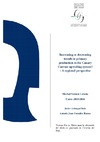Identificador persistente para citar o vincular este elemento:
https://accedacris.ulpgc.es/jspui/handle/10553/74881
| Título: | Increasing or decreasing trends in primary production in the Canary Current upwelling system?. A regional perspective | Autores/as: | Gómez Letona, Markel | Director/a : | Arístegui Ruiz, Javier González Ramos, Antonio Juan |
Clasificación UNESCO: | 251001 Oceanografía biológica | Palabras clave: | Canary Current EBUE Upwelling NPP and Chl-a Phytoplankton functional groups Decadal trends, et al. |
Fecha de publicación: | 2016 | Resumen: | After Bakun (1990) proposed his hypothesis of upwelling intensification caused by increasing global warming, contradictory results have been published on whether primary productivity is increasing or decreasing in Eastern Boundary Upwelling Ecosystems (EBUE). The present work is focused in comparing two net primary production (NPP) models (the Eppley-VGPM and the CbPM), derived from remote sensing data, in the Canary Current EBUE during the 1998-2007 period. We looked for seasonal to interannual trends of NPP under a regional perspective, with the aim of searching for temporal patterns that could support or reject the intensification hypothesis. According to previous studies based on the seasonality of the upwelling regime, the CanC EBUE was divided into three subregions: a seasonal upwelling zone (SUZ; 13-20ºN), a permanent upwelling zone (PUZ; 20-26ºN) and a weak permanent upwelling zone (WPUZ; 26-33ºN). Our analyses did not show significant increasing trends in NPP with any of the two productivity models used, challenging Bakun’s hypothesis. Nevertheless, differences in the output of the two models where significant, both at regional and subregional scales, questioning the accuracy of the models. NPP was compared with proxies of upwelling drivers (Sea-surface temperature, Ekman pumping, nutrients) and community structure (phytoplankton functional groups). Overall, correlations with nutrients and phytoplankton yielded no consistent results, possibly due to the lack of spatial accuracy of these models. Sea-surface temperature, however, showed correlations with some climate indices although varied depending on the time period selected. This disparity of results is also frequently found in the literature, emphasizing the importance of the time period used and the datasets selected, not only for the calculation of correlations, but also for the estimation of trends. | Departamento: | Departamento de Biología | Facultad: | Facultad de Ciencias del Mar | Instituto: | IU de Oceanografía y Cambio Global | Titulación: | Grado en Ciencias del Mar | URI: | https://accedacris.ulpgc.es/handle/10553/74881 |
| Colección: | Trabajo final de grado |
En el caso de que no encuentre el documento puede ser debido a que el centro o las/os autoras/es no autorizan su publicación. Si tiene verdadero interés en el contenido del mismo, puede dirigirse al director/a o directores/as del trabajo cuyos datos encontrará más arriba.
Vista completaVisitas
94
actualizado el 24-feb-2024
Descargas
87
actualizado el 24-feb-2024
Google ScholarTM
Verifica
Comparte
Exporta metadatos
Los elementos en ULPGC accedaCRIS están protegidos por derechos de autor con todos los derechos reservados, a menos que se indique lo contrario.
